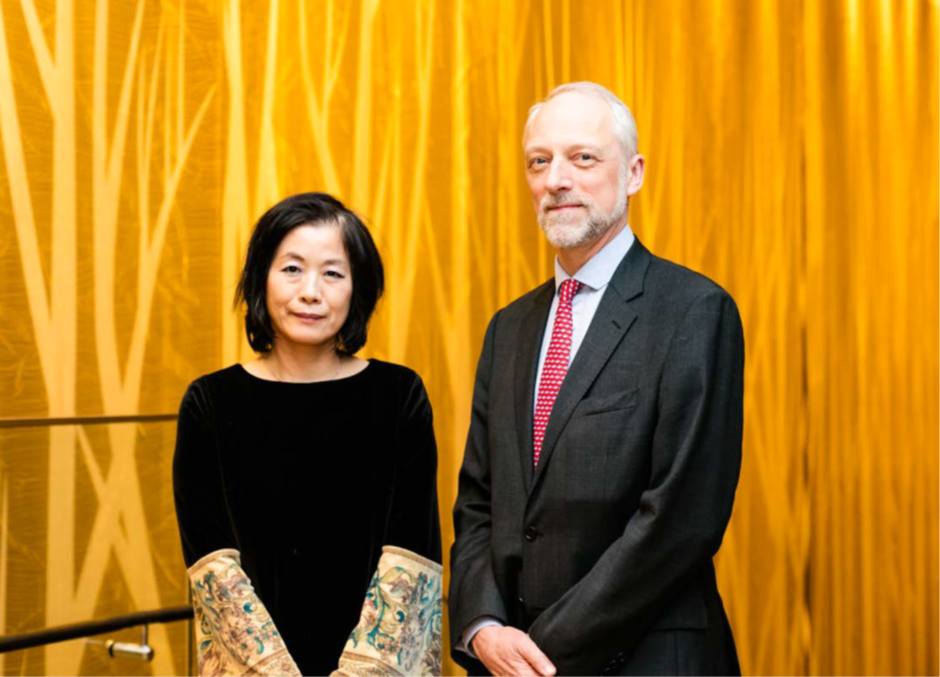
Submitted by Adeline Nicol on Mon, 06/03/2017 - 17:01
AIMR's Director speaks with the world.
What is the Cambridge AJC
AIMR Joint Research Center at Cambridge (Cambridge AJC) is an overseas satellite that AIMR has established at the University of Cambridge in the U.K. The Cambridge AJC was founded through an academic agreement that was concluded in 2012 between Tohoku University AIMR and the University of Cambridge Department of Materials Science & Metallurgy, Department of Chemistry, and Department of Mathematics, and AIMR Director Motoko Kotani and University of Cambridge Professor A. Lindsay Greer renewed the contract for the Cambridge AJC in November of 2015. They are focused on activities that seek developments in the non-equilibrium material field and soft material field, as well as mathematics, and two AIMR researchers are stationed there.
Best Partner
Establishment of overseas bases is an important measure so that AIMR can serve as a hub of global brain circulation. The Cambridge AJC is an ideal base.
Kotani and Greer in conversation....
Greer: More than 4 years have passed since AIMR and the University of Cambridge established the AIMR Joint Research Center at Cambridge (hereafter, "Cambridge AJC"), haven't they?
Kotani: One of my first initiatives after becoming director of AIMR was to strengthen our international network. We selected three organizations out of our 15 partner organizations as core partners - the University of Cambridge, UC Santa Barbara, and the Institute of Chemistry, Chinese Academy of Sciences - and we have certainly established strong collaborative relationships. Then I proposed establishing Joint Research Centers at these three institutions to create a tangible network and to proceed with systematic joint research. Prof. Greer, I remember that you promptly told me "I'd like to give positive consideration to this". Then since AJC was established even at the University of Chicago, there are now 4 bases, but the Cambridge AJC was the first to be implemented. I get the impression that it is still continuing ideal development, and has become a model for AIMR Joint Research Centers. To promote effectively joint research with overseas research institutions, researchers who can act as a bridge need to be jointly appointed at both organizations, and it's important that each can work freely at both organizations. AIMR has created the Cambridge AJC as a place to achieve that and I think we are already seeing a high effect.
Greer: The University of Cambridge has a school tradition of "valuing basic research", so the collaboration with AIMR, which aspires to be world class in basic science, is very familiar to us. I feel that we've been able to have a very high synergistic effect. In 2012 when the Cambridge AJC was established, researcher Dr. Jiri Orava (AIMR Research Associate), who belongs to the Cambridge AJC, and I achieved the outcome of "quantification of crystalization growth rate for chalcogenide liquid in operating temperature range".
Kotani: Yes, that's right. I think the fact that researchers belong to both is very significant. Since we're aiming for systematic joint research, we first held a workshop with Cambridge and SIMR, and discussed in detail plans about joint research in this workshop, we selected the best from among several joint research proposals and started supporting them. Besides your research, Prof. Greer, on metallic glass with Prof. Dimitri Louzguine (AIMR Principal Investigator), Dr Erwin Reisner (Principal Investigator in the University of Cambridge's Department of Chemistry), Dr Katherine Orchard (AIMR Research Associate), Prof. Tadafumi Adschiri (AIMR Principal Investigator), Prof. Naoki Asao (then AIMR Professor, now Shinshu University Professor) have launched a research group as joint research. In terms of the connection between AIMR and the University of Cambridge, I think it's really significant to have the presence of two Cambridge AJC researchers, Dr. Orava and Dr. Orchard. Prof. Greer, from the time when you were young, you also spent time at Tohoku University several times, didn't you? I believe that strong connection is now living on in the Cambridge AJC.
Greer: The first time I came to Tohoku University was in 1981 when I was a postdoctoral fellow. Unfortunately the train schedule from Tokyo to Sendai had been disrupted and not only was it hard to reach the city of trees, I also became sick and ended up spending three weeks in the hospital in Sendai. However, I really felt a strong attachment from this time to Tohoku University, Sendai, and Japan as well. Even on the research side, from this time, I proceeded with joint research on metallic glass little by little. The other day, in another interview with the media I was asked "Why did you choose AIMR as a partner?" to which I answered that "Cambridge seeks only 'best with best' collaborations, and that is what makes the AIMR such an obvious partner in materials science"/ This was a decision based on the "trust" towards joint research with Tohoku University that I've personally continued to experience over many years.
Kotani: Yes, each of the AIMR researchers is individually well known throughout the world, but the Cambridge AJC was created to combine that individual ability into an organization. I'm pleased that by having the Cambridge AJC, new joint research will expand even further.
Greer: Last year as well, we were able to announce both the research outcome with Dr. Orava regarding "phase change memory", and the research outcome with Prof. Louzguine and others regarding "rejuvenation of metallic glass". I really feel that the Cambridge AJC system is actively functioning now.
Kotani: As the director of AIMR, I really have a lot of hope for the Cambridge AJC going forward as well. Well, it's almost time for AMIS2016 (The AIMR International Symposium 2016) reception to start.
Greer: Let's get going. I'm really looking forward to this year's AMIS2016 as well that starts tomorrow.
[21 February, 2016: At the Westin Sendai's 2nd Floor Foyer]
Credit AIMR Magazine.
